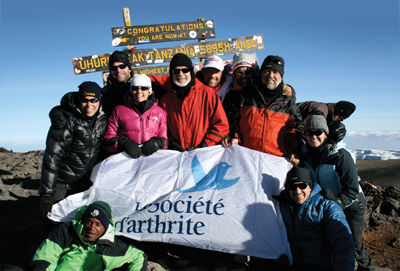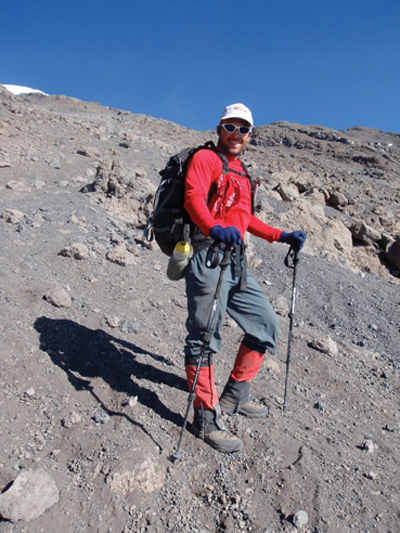
On the morning of Day 4, we awoke to clear skies and saw that our camp
was in the shadow of the cinder cone that now loomed 6,000 feet
directly above us.
Barranco Wall and beyond
On the morning of Day 4, we awoke to clear skies and saw that our camp was in the shadow of the cinder cone that now loomed 6,000 feet directly above us. The day’s first task would be ascending the Barranco Wall – a steep, unforgiving maze of switchbacks and thigh-high steps that rises 800 feet. at a very aggressive angle. Some team members had difficulty with the trail’s close proximity to scary drop offs that would surely put an end to one’s trekking for the day, if not for a lifetime! At the summit of the wall we found a number of porters encouraging us with singing and clapping. It was a feel-good moment that brought the porters and trekkers together in celebration of a job well done.
 |
|
| Ryan Iverach and his trekking group atop the summit of Mt. Kilimanjaro. Advertisement
|
With the Barranco Wall behind us a rather bizarre, relatively level moonscape lay before us. The flat terrain made for an easy 4 km traverse to the edge of an 800 feet gorge that we needed to descend and then immediately ascend to reach Karanga Camp (13,500 feet). The gorge left many of us asking, “Where’s the suspension bridge?” and dreaming of a zipline that would spare our weary legs.
Bedtime at Karanga Camp brought with it a fair amount of anxiety with the thought that the next day would be the start of our bid for the summit. Sleep apnea and general restlessness were now beginning to make me not look forward to “going to sleep.” The night was a frustrating experience of repeatedly glancing at my watch only to realize that mere minutes had past since the last time I had glanced at my watch. An agonizing feeling given my level of general fatigue at that time!
Morning came, on Day 5, and a certain level of excitement was palpable throughout the group. Our four hour trek to the final camp started at 9 a.m. and took us through fields of large lava rock boulders on yet another dusty trail. The temperature was hovering around zero Celsius, the sky was overcast, and I stayed busy continually checking in on members of our group to monitor them for signs of altitude sickness. (One member was not doing well, despite – doubling his dose of Diamox 0, an altitude sickness medication – and slowing his pace significantly.)
Snow greeted us at the Barafu Camp, and I suddenly had a feeling that it was “game on” from here. While most of our group rested for the afternoon, my tentmate and I opted for a two hour acclimatization hike to 16,100 feet with one of the assistant guides. This gave us confidence, and killed what would have otherwise been a period of trying to pass the time by sleeping in our tent.
Dinner time came soon enough and, although no one was hungry, we all knew that eating was a necessity if we were going to fuel our bodies for the long ascent that would start in a few hours. By 8 p.m. we were resting again in our tents, anxiously trying to sleep before an 11:30 p.m. wake up call that would signify the beginning of our climb to the top.
The push for the summit
The night was eerily calm under the full moon as we left our tents to assemble with the six guides who would go with us to the top. As Richard, our guide, turned to start, I slipped in immediately behind him. My years of endurance sports had taught me that controlling the pace of a group was done at the front of the pack, not the rear.
Eight inch step after eight inch step we trudged upward for seven long hours with breaks only for ingesting food and water – or excreting it! I was using every mental trick I had learned during 13 years of triathlon activity to convince myself to keep going, all the while rationalizing why I had gotten myself into this situation, and praying that the time estimates for the ascent made by our guides were either exact or exaggerated.
We conquered false summit after false summit, wondering if there really was a top to this mountain.
 |
|
| Dr. Ryan Iverach descending after his climb to the summit of Mount Kilimanjaro.
|
As dawn approached, I glanced up to see that the crater rim was only 100 feet away, then glanced back to see that our group had splintered and was now strung out for several 100 feet down the pumice slope. The lead guide and I embraced briefly and congratulated each other on making it to the crater rim, just as the sun burst over the horizon. It was a truly awe-inspiring site on what was, incredibly, a perfectly clear, blue sky morning. Within minutes, several others had joined us on the rim and many hugs were being exchanged.
I was quick to point out, however, that the true summit of Uhuru Peak was still a 45 minute trek away. We needed to stifle the celebrations until we were at the top! I left the group in the dust and continued alone to the peak.
With the ice giving way to expansion in the warmth of the day, huge ice serracs could be heard creaking and cracking, as I passed by the massive summit glacier on my way to Uhuru Peak. I felt surprisingly good – no headache, no nausea, only a racing heart rate that I found difficult to control as my pace picked up in the excitement of knowing I was almost at the top.
On top of the world
And then I was there – Uhuru Peak – the summit sign, the view, the amazing feeling that my goal had been accomplished on behalf of my father and millions of arthritis sufferers.
My team soon joined me and the real celebration began with hugs, tears, and many pictures. But our trek wasn’t over – we still had another eight hour descent to Mweka Camp, almost 10,000 feet below us! By the time we reached Mweka we had hiked for 19 hours out of the past 36. It didn’t seem to matter though – we were all riding the high of success.
Our final day took us back into the jungle for a four hour trek to Mweka Gate. We were all very relieved when we rounded the final corner and the trail yawned open to reveal the trucks that would take us back to civilization.
I relaxed. I smiled. I laughed. I silently thanked the mountain for allowing me safe passage to her summit and back down.
How chiropractic played a role
On a professional note, my training as a chiropractor prepared me for this journey by giving me an understanding of the human body that allowed me to better comprehend how high altitude trekking effects the body. I was able to contribute to the well-being of the group in a way that no other member could, simply by volunteering to be the healthcare liaison for the team. Most of my trekking group expressed gratitude for the feeling of comfort and assurance they were afforded knowing that someone in their group was capable of making healthcare decisions, and advising them on strategies for avoiding the complications that high altitude trekking can present. Although our group didn’t experience any emergency situations, the potential was always present. Having the confidence to respond if need be was a testament to my training as a healthcare professional. Participating in the trek raised my awareness about the different forms of arthritis, and gave me an entirely new appreciation for the challenges of fundraising in a slow-moving economy. Volunteering for such an event is time-consuming, but I found that the rewards of philanthropy were more than an equitable trade for my investment of time and energy.
Print this page